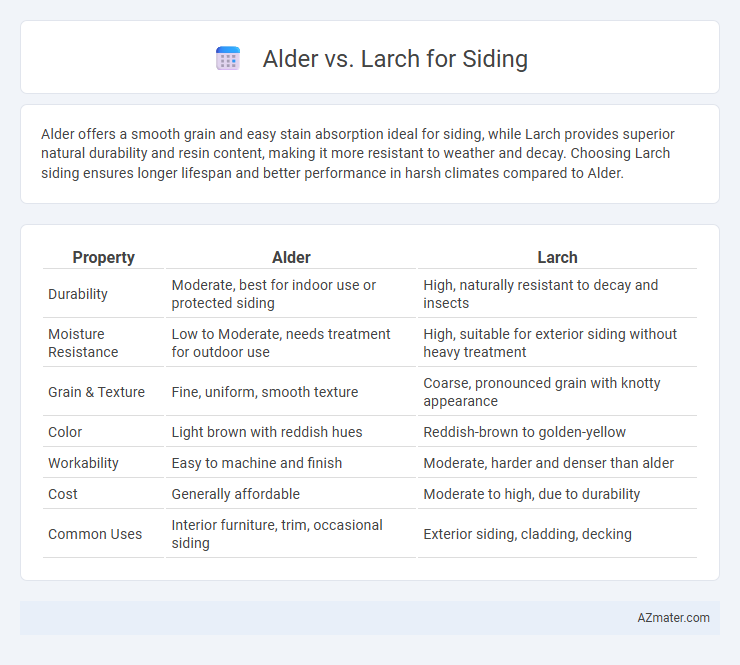Alder offers a smooth grain and easy stain absorption ideal for siding, while Larch provides superior natural durability and resin content, making it more resistant to weather and decay. Choosing Larch siding ensures longer lifespan and better performance in harsh climates compared to Alder.
Table of Comparison
| Property | Alder | Larch |
|---|---|---|
| Durability | Moderate, best for indoor use or protected siding | High, naturally resistant to decay and insects |
| Moisture Resistance | Low to Moderate, needs treatment for outdoor use | High, suitable for exterior siding without heavy treatment |
| Grain & Texture | Fine, uniform, smooth texture | Coarse, pronounced grain with knotty appearance |
| Color | Light brown with reddish hues | Reddish-brown to golden-yellow |
| Workability | Easy to machine and finish | Moderate, harder and denser than alder |
| Cost | Generally affordable | Moderate to high, due to durability |
| Common Uses | Interior furniture, trim, occasional siding | Exterior siding, cladding, decking |
Introduction to Alder and Larch Wood
Alder wood is a soft hardwood prized for its smooth texture, warm reddish-brown hues, and excellent workability, making it ideal for siding with a naturally uniform appearance. Larch wood, known for its durability and resistance to decay, features a distinct grain pattern with golden to reddish tones, providing strong weather resistance and a rustic aesthetic for exterior applications. Both woods offer unique benefits, with alder favored for indoor and mild climates, while larch excels in harsher environments due to its robust structural properties.
Key Characteristics of Alder Wood
Alder wood, known for its fine, straight grain and smooth texture, offers a warm, reddish-brown hue that darkens over time, making it ideal for siding that requires aesthetic appeal. It is moderately durable but less resistant to decay and insects compared to larch, requiring proper sealing and maintenance to ensure longevity. Alder is easier to machine and stain, providing versatility in finishes, but it is softer and less weather-resistant, which can limit its application in harsh outdoor conditions.
Key Characteristics of Larch Wood
Larch wood is highly valued for siding due to its exceptional durability and natural resistance to rot and insect damage, making it ideal for exterior applications. Its tight, straight grain and rich reddish-brown color enhance both the aesthetic appeal and structural integrity of buildings. Larch also offers superior dimensional stability compared to alder, reducing warping and swelling under variable weather conditions.
Durability: Alder vs Larch for Siding
Larch siding offers superior durability compared to alder due to its natural resistance to decay, moisture, and insect damage, making it ideal for exterior applications. Alder is softer and more prone to dents and scratches, requiring more maintenance and protective treatments to ensure longevity. For long-lasting siding that withstands harsh weather conditions, larch is the preferred choice.
Appearance and Visual Appeal Comparison
Alder siding offers a warm, rich appearance with smooth grain and a reddish-brown hue that deepens over time, enhancing curb appeal with a classic, elegant look. Larch siding features a more rustic texture, characterized by pronounced knots and a golden-yellow to reddish-brown color that weathers naturally to a soft silver-gray, providing a distinctive, rugged charm. The choice between Alder and Larch siding depends on whether homeowners prefer the refined, uniform aesthetic of Alder or the textured, natural beauty of Larch for their exterior design.
Resistance to Weather and Decay
Larch wood is highly valued for siding due to its exceptional resistance to weather and decay, attributed to its dense grain and natural resin content. Alder, while aesthetically pleasing and easy to work with, generally lacks the durability of larch when exposed to harsh weather conditions and is more prone to decay over time. Choosing larch for siding ensures longer-lasting protection and reduced maintenance in outdoor environments.
Maintenance Requirements for Each Option
Alder siding demands regular sealing and staining every few years due to its softer wood fiber, which is more prone to dents and moisture damage. Larch siding offers naturally high resin content that enhances durability, requiring less frequent maintenance and providing better resistance to rot and insect infestation. Choosing larch siding reduces long-term upkeep costs, while alder may need more proactive care to maintain its appearance and structural integrity.
Cost Analysis: Alder vs Larch Siding
Alder siding typically costs between $4 and $7 per square foot, offering an affordable option with moderate durability and a warm, reddish-brown appearance. Larch siding, priced around $6 to $9 per square foot, provides superior resistance to decay and weathering, making it a long-lasting investment despite a higher upfront cost. When analyzing cost-effectiveness, larch siding's longevity and lower maintenance requirements often outweigh alder's initial price advantage.
Environmental Impact and Sustainability
Alder and larch siding differ significantly in environmental impact and sustainability, with larch being more eco-friendly due to its natural resistance to decay, reducing the need for chemical treatments. Alder grows faster, making it a more renewable resource, but its shorter lifespan means more frequent replacement compared to the highly durable larch. Choosing larch siding supports sustainable forestry practices and offers long-term energy savings due to its superior insulation properties.
Best Applications and Recommendations
Alder wood, known for its smooth grain and moderate durability, is best suited for interior siding and decorative paneling where a warm, consistent appearance is desired. Larch wood offers superior resistance to moisture and decay, making it ideal for exterior siding applications, especially in climates with high humidity or heavy precipitation. For long-lasting siding, larch is recommended in outdoor environments, while alder provides aesthetic appeal for interior settings.

Infographic: Alder vs Larch for Siding
 azmater.com
azmater.com